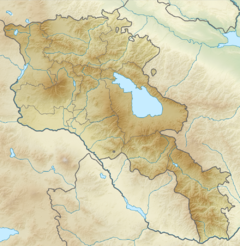Orgov Radio-Optical Telescope
 | |
| Alternative names | Radio Optical Observatory ROT54 |
|---|---|
| Named after | Paris Herouni, Orgov |
| Location(s) | Orgov, Aragatsotn Province, Armenia |
| Coordinates | 40°21′03″N 44°14′27″E / 40.35089°N 44.24086°E |
| Altitude | 1,711 m (5,614 ft) |
| Built | 1975–1985 |
| First light | 1986 |
| Telescope style | optical telescope radio telescope |
| Diameter | 54 m (177 ft 2 in) |
| Secondary diameter | 5 m (16 ft 5 in) |
| | |
The Orgov Radio-Optical Telescope, also known as ROT54 or the Herouni Mirror Radio Telescope, is a radio telescope in Orgov, Armenia.
Specifications
The telescope is located at the RRI Aragats Scientific Centre in Orgov, Armenia. It is on Mount Aragats,[1] at a height of 1,711 metres (5,614 ft).[2]
The radio telescope has a diameter of 54 m (177 ft). It is hemispherical, and fixed to the ground, with a movable secondary mirror with a diameter of 5 m (16 ft).[1] This provides a useful diameter of 32 m (105 ft). It has a surface accuracy around 70/100 μm, giving an operating wavelength of 30-3mm (10-100 GHz),[3] and was originally designed to observe down to 1 mm (300 GHz).[1]
The optical telescope has a 2.6 m (8.5 ft) mirror, with a 10 m (33 ft) focal length.[1] Telescope never operates from the date of its implementation.
History
Construction took place between 1975 and 1985,[1] first operating in 1986.[3] It was not damaged by the 1988 Armenian earthquake,[2] and was used for observations between 1987 and 1990.[2]
It stopped being used around 1990, and in the mid-1990s a plan to restore the telescope to use it for astronomy was proposed.[3] It was subsequently restructured in 1995-2010, with a new control computer, new feeds, and observations in collaboration with the Astronomical Society of Russia and the National Technical University of Athens.[2]
From around 2012 onwards, moving the secondary mirror was not possible due to a defective control arm, with a restoration plan in 2018 so that the telescope can be used in the European VLBI Network.[2]
References
- ^ a b c d e Herouni, Paris M. (2007). "Measured Parameters of Large Antenna of ROT-54/2.6 Tell about Absence of Big Bang" (PDF). National Academy of Sciences of Armenia Reports. 107: 73.
- ^ a b c d e Sargsyan, Arevik (4–5 October 2018). "Presentation of ROT-54/2.6" (PDF).
- ^ a b c Martin, J. M.; Rosolen, C. (October 1995). "Perspectives of the ROT 54/32/2.6 in astronomy". Astrophysics. 38 (4): 361–363. Bibcode:1995Ap.....38..361M. doi:10.1007/BF02044713. S2CID 124009116.

